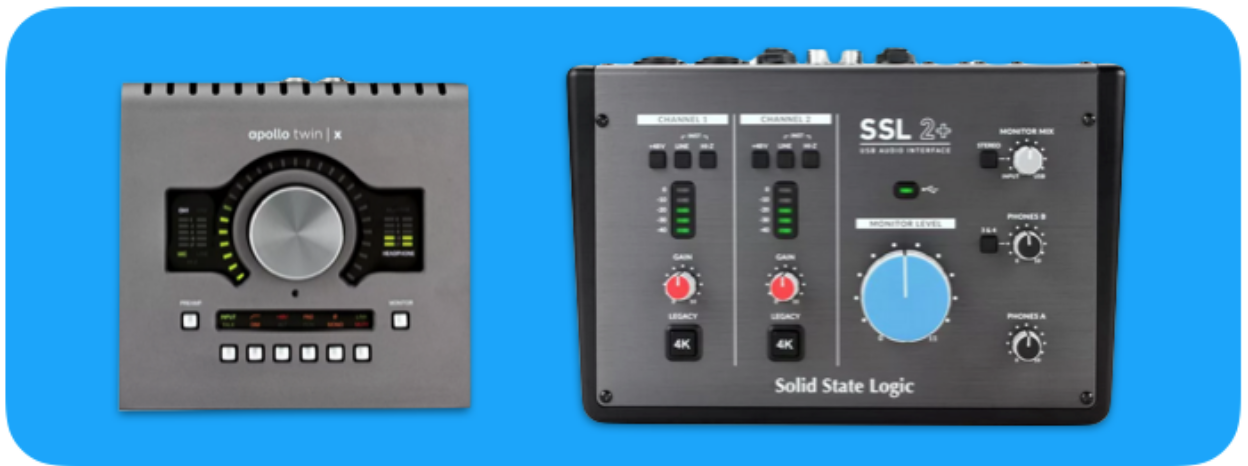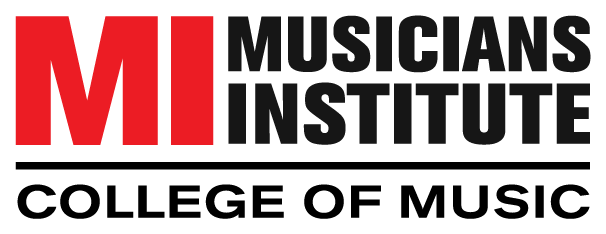The following blog was produced by Sonarworks in collaboration with MI. The author Adam Kagan is an instructor in the Audio Engineering program, and in this blog, he gives guidance on audio interfaces and why they are important to have as a musician.
You shouldn’t let technology get in the way of your creativity, but at some point a certain amount of tech is necessary. The right gear can inspire you, speed up your work, and even guarantee what you hear is what everyone else hears. One of the first decisions you’ll come to when getting started in music production is how to get sound into and out of your computer. Let’s take a look at your options.
What does an Audio Interface do?
Audio interfaces convert microphone and instrument signals into a format your computer and software recognize. The interface also routes audio from your computer out to your headphones and studio monitors. Interfaces typically connect to your computer via USB cables, though some use Thunderbolt, Firewire, or even ethernet. Interfaces range in price from well under $100 to several thousand dollars, and even the most affordable interfaces sound great and provide the basic features.

Blog Post
"*" indicates required fields
By submitting this form, I authorize Musicians Institute (MI) to make or allow the placement of calls, emails, and texts to me at the phone number that I have provided, including through the use of automated technology, or a prerecorded or artificial voice. I understand that I am not required to provide my phone number as a condition of purchasing any property, goods, or services. I agree to the terms of MI’s Privacy Policy. MI will not sell or rent your information to third parties, and you may unsubscribe at any time.

Focusrite Scarlett 2i2 interface. Mic, instrument, and headphone connections are on the front panel (left image) while the USB and speaker connections are on the rear (right image).
USB Mic or Interface?
If you use only one microphone and a USB mic works for you (see our blog post about microphones), then you may not need an audio interface. If you monitor on speakers or wish to use XLR microphones, then it might be time to explore purchasing a dedicated audio interface.
The advantages of an audio interface are these:
- You can use any XLR microphone
- You can use more than one microphone at a time (USB mics allow only one mic to connect)
- The headphone output in a USB interface will sound better and louder than the headphone out of a USB mic or laptop ‘phone jack
- Most interfaces provide inputs for guitar/bass/keyboards as well as mics
- Interfaces provide volume control for at least one pair of speakers and some provide multiple headphone and speaker outputs.
Choosing an Interface
Here is a list of questions to ask yourself when deciding which interface is right for you:
- What kind of connection does my computer provide (USB, Thunderbolt, Ethernet)?
- How many mics will I want to use at one time?
- Do I need to control volume for headphones and speakers (or more than one pair of speakers)?
After you’ve answered these basic questions, here are a few more advanced questions to think about:
- Do I need separate headphone feeds and talkback for an artist in another room?
- Do I want onboard DSP for plugins, like those from UAD or Antelope Audio?
- Do I want to record at high sample rates (96kHz or above)?
- Will I want to expand to more mic/instrument inputs in the near future?
- Do I need other features, like MIDI, digital connections, or reamping outputs?

The UAD Apollo Twin (L) and the SSL2+ (R) interfaces provide a wide range of features, including onboard DSP for plugins, headphone outputs for the engineer and artist, excellent mic preamps, and MIDI connections
Entry-Level Interfaces
These interfaces provide the basic features with excellent sonic qualities. These low-cost models typically provide only one or two inputs and support only one pair of monitors and headphones. Companies including Focusrite, Audient, PreSonus, SSL, Behringer, and others make excellent, modestly-priced units.
Behringer U-Phoria UM2 ($59) – provides one mic and one instrument input along with volume control for headphones and one pair of speakers.
PreSonus AudioBox USB96 ($99) – provides two mic/instrument inputs along with volume control for headphones and one pair of speakers and even MIDI connections.
Focusrite Scarlett 2i2 ($180) – provides 2 inputs for mic, line, or instruments, great-sounding mic preamps, headphone output, and speaker level control for one pair of speakers.
Beyond Entry-Level but Affordable
Interfaces at this price range add useful features like multiple inputs, cue mixes, onboard DSP, and higher quality electronics. These devices may be USB, Thunderbolt, or both. Companies like UAD, PreSonus, MOTU, and others make interfaces in this price range.
Focusrite Scarlett 8i6 ($250) – provides 2 mic inputs and 4 additional inputs, allowing you to use up to 6 microphones (with your choice of external mic preamps). Includes digital input and output, speaker and headphone control, and even MIDI connections.
UAD Apollo Twin MKII ($799) – provides 2 mic/line inputs and 1 guitar/bass DI input. Comes with onboard DSP and includes plugins of classic compressors, equalizers, reverb. and amp simulators. Provides. Provides cue mix and talkback for artists and can be expanded for more inputs and outputs by cascading multiple UAD interfaces together as you grow your studio.
PreSonus Quantum 2626 ($599) – provides 8 mic/line inputs plus 16 digital inputs, 8 analog and 16 digital outputs plus 2 separate headphone levels, and control for one set of studio monitors. MIDI i/o is also provided.
Pro Sound and Features
These interfaces provide professional quality converters and features. Avid, Apogee, Lynx, and Prism Sound, among other companies, make interfaces suitable for high-end studio recording with any DAW. Here are some of the least expensive, but professional interfaces. These devices may be USB, Thunderbolt, ethernet or they may have special connectors for ProTools HDX systems.
RME Fireface UCX ($1700) Superior audio quality, 2 mic plus 6 line inputs and 8 outputs. Also provides digital i/o plus word clock connections plus MIDI. Also provides latency-free effects for tracking.
MOTU 8M ($1495) 8 Mic preamps for large tracking setups and 16 additional digital inputs. 8 Analog and 16 digital outputs. Provides onboard DSP mixer for creating latency-free monitor mixes. Digital i/o, USB, Thunderbolt, and AVB (Ethernet) supported.
Antelope Audio Zen Tour ($1695) Provides 4 mic and 4 line/instrument inputs, 8 analog outs, 2 separate headphone, and 2 separate speaker ouptuts. Provided digital i/o, reamp outputs, and onboard DSP for Antelope’s effect plugins.

